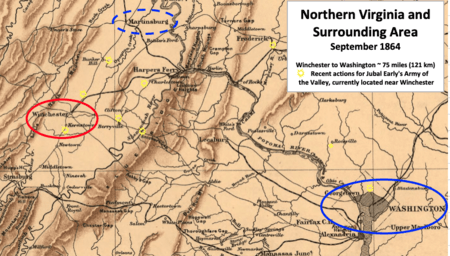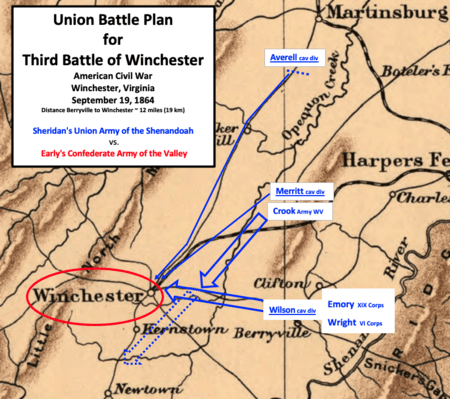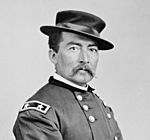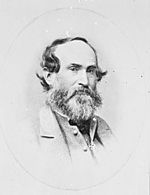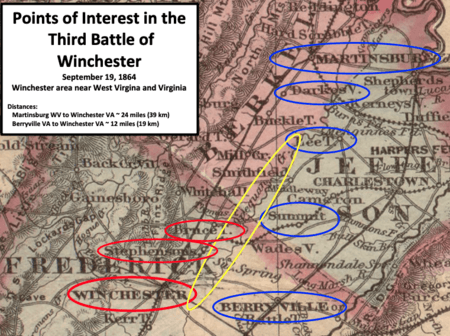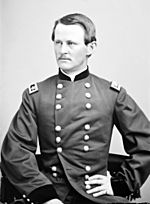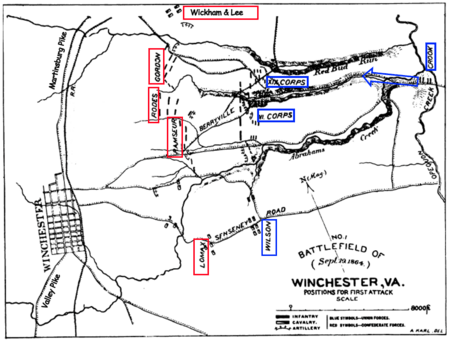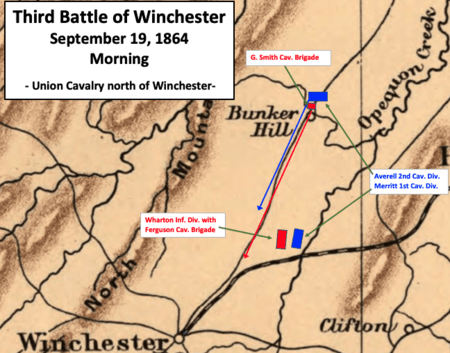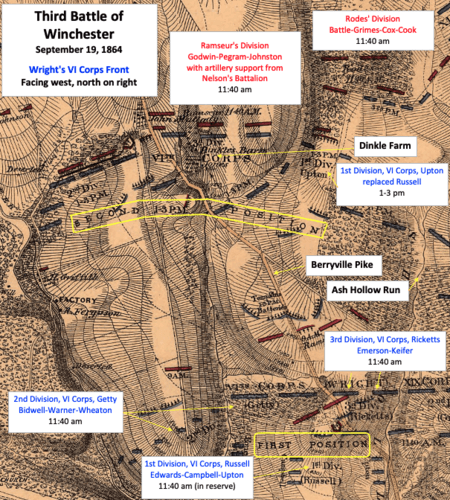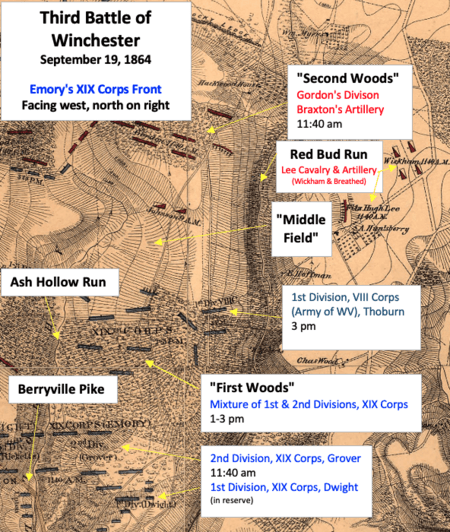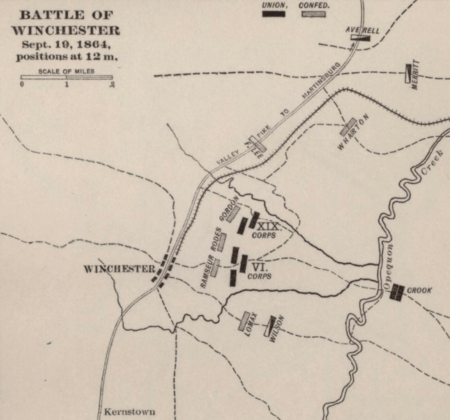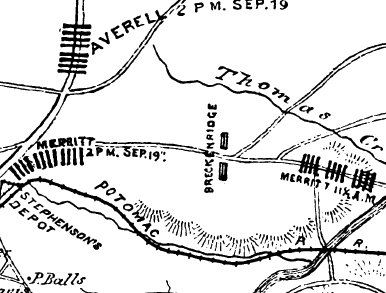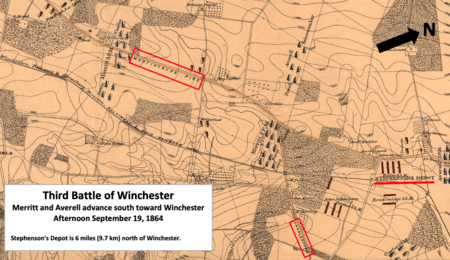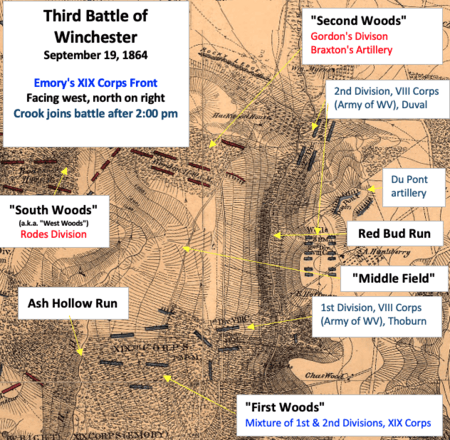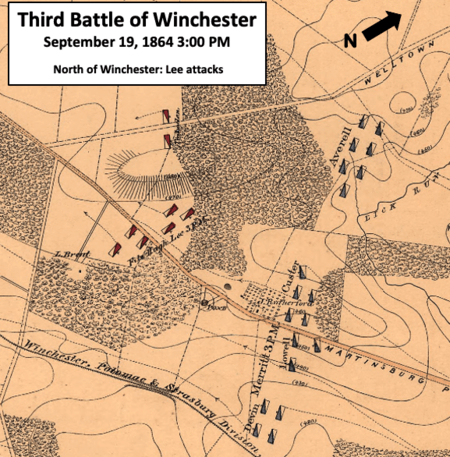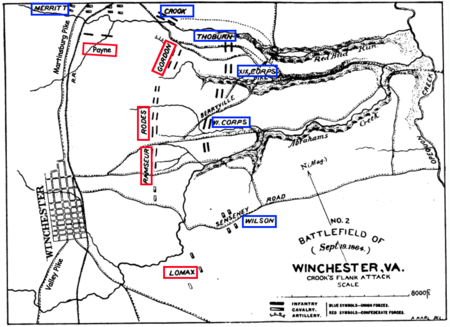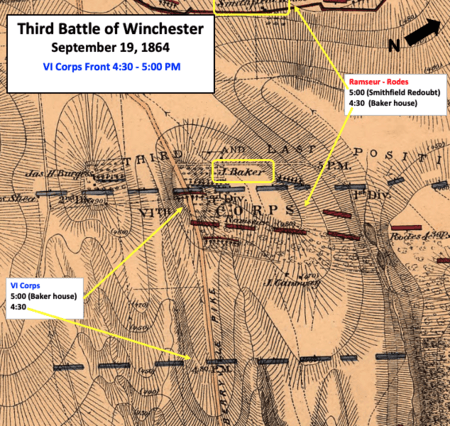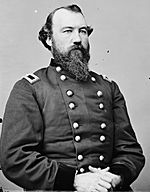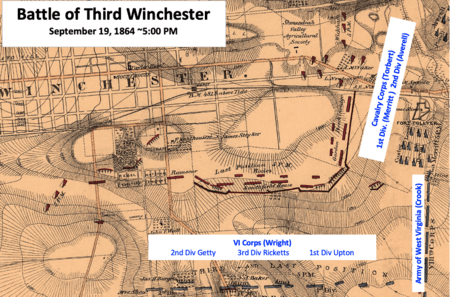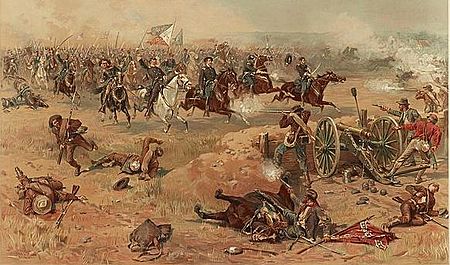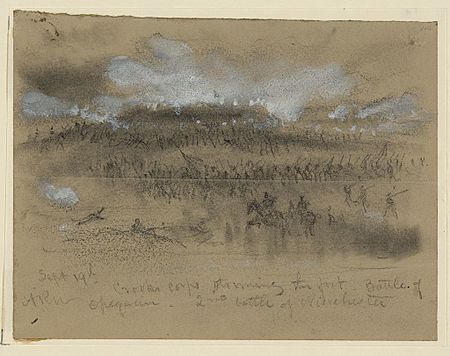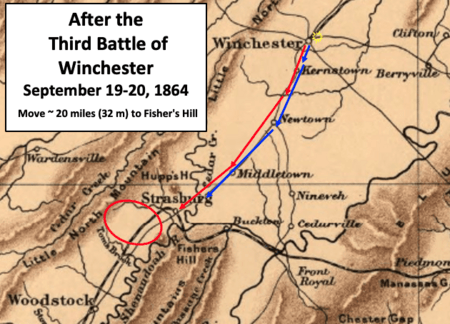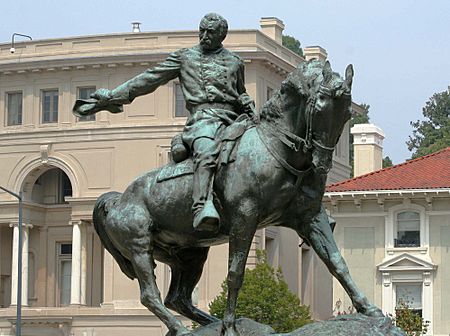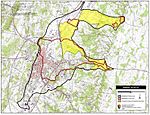Third Battle of Winchester facts for kids
Quick facts for kids Third Battle of Winchester(Battle of Opequon) |
|||||||
|---|---|---|---|---|---|---|---|
| Part of the American Civil War | |||||||
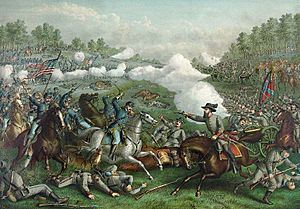 Battle of Opequon, chromolithograph by Kurz & Allison, 1893. |
|||||||
|
|||||||
| Belligerents | |||||||
| Commanders and leaders | |||||||
| Units involved | |||||||
Army of the Shenandoah
|
Army of the Valley
|
||||||
| Strength | |||||||
| 40,000 | 15,514 | ||||||
| Casualties and losses | |||||||
| 5,018 | 4,015 | ||||||
The Third Battle of Winchester, also known as the Battle of Opequon, was a major battle during the American Civil War. It happened near Winchester, Virginia, on September 19, 1864. In this battle, Union General Philip Sheridan led his troops to victory over Confederate General Jubal Early.
This fight was one of the biggest and bloodiest battles in the Shenandoah Valley. The Union army had about 40,000 soldiers, while the Confederates had around 15,500. Both sides suffered many losses. The Union had over 5,000 casualties, and the Confederates had about 4,000. Important people who fought in this battle included two future U.S. presidents.
General Sheridan attacked after learning that some Confederate troops had left General Early's army. Sheridan used his cavalry and infantry to attack from different directions. The fighting was tough, but the Union forces eventually pushed the Confederates back. Early's army had to retreat through Winchester. This Union victory was a key moment in Sheridan's campaign to control the Shenandoah Valley.
Contents
- Why the Battle Happened
- Who Fought in the Battle
- The Battle Begins
- Morning: Infantry and Cavalry Get Ready
- Union Infantry Attacks from the East
- Early Moves His Forces
- Torbert Pushes South
- Crook Joins the Battle
- Lee Attacks Torbert
- Mid-Afternoon Attack: Crook Leads the Way
- Early's Final Stand
- Battle Ends
- What Happened Next
Why the Battle Happened
By 1864, the Civil War had been going on for four years. Confederate General Jubal Early's actions in the Shenandoah Valley were worrying Union leaders. Early's army was a threat to Washington, D.C., the Union capital.
Union General Ulysses S. Grant told General Philip Sheridan to be careful. Grant knew Early had received more soldiers. Sheridan's job was to keep Early's army away from Washington. He also needed to stop the Valley from supplying the Confederate army.
Sheridan kept his troops between Early's army and Washington. They fought some smaller battles, like the Battle of Berryville. After that battle, Early moved his army west of Opequon Creek. Sheridan's army stayed in place for a few weeks. Early thought Sheridan was not a very bold commander.
Sheridan's Secret Plan
General Sheridan wanted to know how many soldiers Early had. His scouts found a man named Thomas Laws, who was a slave with a pass to enter Winchester. Laws agreed to carry secret messages.
A schoolteacher in Winchester, Rebecca Wright, also helped. She sent information to Sheridan through Laws. On September 16, Sheridan learned that a large group of Confederate soldiers had left Early's army. These soldiers were sent back to help General Robert E. Lee near Richmond.
With this important news, Sheridan decided to attack. He planned to send his infantry to Newtown to block Early's retreat. His plan changed a bit when Early moved some of his troops to Martinsburg, West Virginia.
Sheridan's final plan was to attack Early from different sides. Two cavalry divisions would attack from the north. Another cavalry division would lead two infantry groups from the east. A third infantry group would be held back to block Early's escape route.
Who Fought in the Battle
The Union Army
The Union army was called the Army of the Shenandoah. It was led by Major General Philip Sheridan. This army had three main goals. First, push Early's army out of the northern Shenandoah Valley. Second, destroy the Valley's ability to provide food for the Confederates. Third, disrupt the Virginia Central Railroad.
In mid-September, Sheridan's army had about 40,000 soldiers.
- The VI Corps was led by Major General Horatio Wright. These soldiers were experienced fighters.
- The XIX Corps was led by Brigadier General William H. Emory.
- The Cavalry Corps was led by Brigadier General Alfred Torbert. Many of their cavalry soldiers had repeating rifles, which were a big advantage.
- The Army of West Virginia acted as an infantry group. It was led by Brigadier General George Crook. Crook was a skilled soldier. Two future U.S. presidents, Rutherford B. Hayes and William McKinley, served in Crook's army.
The Confederate Army
The Confederate army was called the Army of the Valley. It was led by Lieutenant General Jubal Early. This army's main job was to protect the Shenandoah Valley. The Valley was a key source of food for the Confederate armies. It also aimed to threaten Washington, D.C., to draw Union troops away from Richmond.
Early's army had about 15,500 soldiers for this battle. Many of these soldiers were from Virginia and North Carolina.
- Breckinridge's Corps was led by Major General John C. Breckinridge. He had been a U.S. vice president before the war. A colonel in his corps, George S. Patton, had a grandson who became a famous general in World War II.
- The Cavalry Corps was led by Major General Fitzhugh Lee. He was a nephew of General Robert E. Lee.
The Battle Begins
Union Cavalry Attacks from the East
On September 19, 1864, Union cavalry began moving early in the morning. General James H. "Harry" Wilson's cavalry division led the way. They moved west from Berryville towards Winchester. They quickly secured a key position overlooking a creek crossing.
The cavalry, using their repeating rifles, attacked Confederate defenses. They captured some important earthworks, lost them, and then captured them again. This fighting created a stalemate for a while.
Behind Wilson's cavalry, the main Union infantry groups were moving. But a huge traffic jam happened on the narrow road. Wagons, ambulances, and soldiers all tried to move at once. This delay meant the infantry arrived hours later than planned.
Union Cavalry Attacks from the North
Two other Union cavalry divisions also started moving early. General Wesley Merritt's division advanced from the northeast. They met Confederate resistance at creek crossings. The fighting was tough, but Merritt's cavalry eventually pushed the Confederates back. By 7:00 AM, they were safely across the creek.
General William W. Averell's cavalry division moved from the north. They encountered Confederate pickets, who quickly retreated. Averell's cavalry continued south, getting closer to the rear of Early's army.
Morning: Infantry and Cavalry Get Ready
Union and Confederate Positions
By 9:00 AM, the Union VI Corps was in position, about two miles from Winchester. The XIX Corps was delayed by the traffic jam and didn't get into place until 11:00 AM. General Crook's two divisions were held back as a reserve.
The delay allowed General Early to move more Confederate infantry divisions to the front. He brought troops from north of Winchester to support his main line. This prevented the Union from easily overwhelming the Confederates.
Cavalry Movements
After the Union infantry arrived, Wilson's cavalry moved south. They were now on the far left of the Union line. This put them close to Early's escape route.
Averell's cavalry continued pushing south from the north. They faced some Confederate cavalry and artillery. Averell used his artillery to drive them back. He kept moving closer to Stephenson's Depot, which was behind a part of Early's army.
Merritt's cavalry also slowly advanced. They attacked a Confederate position but didn't push too hard. Their goal was to keep the enemy busy and away from the main Union infantry attack.
Union Infantry Attacks from the East
The main Union infantry attack began around 11:40 AM. Wright's VI Corps and Emory's XIX Corps attacked almost at the same time. The Union forces had more soldiers than the Confederates in this area.
VI Corps Attack
Wright's VI Corps pushed forward, causing the Confederates to retreat at first. However, the rough ground made it hard to see the enemy. Confederate artillery also hit them hard, slowing their advance. One Union brigade pushed too far ahead, getting separated. This brigade was then attacked by Confederate reinforcements and forced to retreat in confusion.
XIX Corps Attack
Emory's XIX Corps also attacked. They had some early success, pushing the Confederates back through open fields and woods. But some Union brigades moved too fast, leaving gaps in their lines. Confederate artillery, hidden in haystacks, fired at close range, causing heavy losses.
Confederate reinforcements arrived and counterattacked. This forced the Union troops to fall back. The XIX Corps suffered many casualties and had to switch to defending their positions.
Union Line Saved
As parts of the Union line began to break, General David Allen Russell's division of the VI Corps stepped in. Colonel Oliver Edwards's brigade, armed with repeating rifles, helped stop the Confederate advance. General Russell was killed by a shell fragment while leading his men. General Emory Upton took command and helped restore the Union line. This was a critical moment that saved the Union attack from collapsing.
Early Moves His Forces
Around 12:30 PM, Averell's cavalry was getting very close to Stephenson's Depot, behind a part of Early's army. General Breckinridge, a Confederate commander, was told to retreat before Averell cut off his path. Breckinridge's troops secretly pulled back through the woods.
As Breckinridge arrived at Stephenson's Depot, he found Averell's cavalry pushing back Confederate forces. Breckinridge fought back and pushed Averell north. This allowed more Confederate troops to retreat towards Winchester.
Early also moved other cavalry and artillery units to strengthen his flanks. He put General Fitzhugh Lee in charge of all cavalry north of Red Bud Run.
Torbert Pushes South
Around 1:30 PM, General Torbert ordered Merritt's cavalry division to advance. They moved towards Stephenson's Depot. Merritt's and Averell's cavalry divisions eventually linked up, forming a large Union force.
They slowly advanced towards Winchester. Confederate cavalry and artillery tried to stop them. In one fight, Union cavalry used their sabers effectively, causing the Confederates to panic and retreat.
Crook Joins the Battle
General Crook's two infantry divisions, held in reserve, began moving forward around 1:00 PM. Crook decided to attack Early's left flank, which was held by General Gordon's division. This would relieve pressure on the Union XIX Corps.
Crook's troops crossed Red Bud Run and found themselves unopposed. Union artillery was set up, allowing them to fire on the Confederate positions. This was a big advantage for the Union.
Lee Attacks Torbert
Around 3:00 PM, Torbert's Union cavalry advanced south towards Winchester. They rode through an open field towards a wooded area. Hidden in the woods was General Lee's outnumbered Confederate cavalry.
Lee attacked, pushing back the Union cavalry for a short distance. But the Union cavalry fought back fiercely, using their sabers and repeating carbines. The Confederates were eventually forced to retreat in panic. Lee's men were scattered and could not regroup until they were behind Confederate infantry.
Mid-Afternoon Attack: Crook Leads the Way
Duval and Thoburn Attack
At 3:00 PM, Crook's divisions charged across Red Bud Run. They faced Confederate artillery and infantry. The ground was swampy in places, making it hard for the Union soldiers to advance. Confederate reinforcements also arrived to help.
However, another of Crook's divisions, led by General Joseph Thoburn, attacked from a different angle. They hit the Confederates from two sides, forcing them to fall back. This began a disorganized retreat for some Confederate units.
VI Corps Advances
As Crook's attack began, General Sheridan rode among his VI Corps infantry, inspiring them to attack again. They began to advance on both sides of the Berryville Pike. By 4:30 PM, they were pushing the Confederates back.
The Confederates could see their lines breaking on their left. This forced them to retreat further. Confederate artillery tried to slow the Union advance, but it was becoming harder to hold the line.
Cavalry Attacks from Southeast and North
Wilson's cavalry division also joined the attack from the southeast. Their commander, General John B. McIntosh, was severely wounded while leading a charge. This hurt the effectiveness of Wilson's division.
Meanwhile, Devin's Union cavalry attacked a Confederate brigade with sabers. They captured many soldiers and battle flags. This forced the Confederates back, allowing Crook to capture key positions.
Averell's cavalry aggressively advanced west of the main road. They captured cannons and soldiers. One of Averell's commanders even earned a Medal of Honor for capturing a small fort. Other Union cavalry units pushed Confederate cavalry into Winchester, causing panic in the town.
Confederate forces tried to regroup, but the Union cavalry was relentless. General Lee, the Confederate cavalry commander, was seriously wounded.
Early's Final Stand
General Early's army made a final stand in and around Winchester. They used redoubts (small forts) and stone walls to defend themselves. Confederate artillery was placed to fire on the advancing Union troops.
VI Corps Presses from East
The Union VI Corps continued to push from the east. General Upton, despite being wounded, refused to leave the battlefield and led his division forward. The Union artillery also fired heavily, eventually silencing many Confederate guns.
Merritt and Crook Advance from North
General Sheridan was now on the northern front, inspiring his soldiers. Merritt's cavalry, led by General George Armstrong Custer, charged the northern side of the Confederate defenses. They attacked with sabers, breaking the Confederate lines. This charge effectively destroyed a major Confederate infantry division.
Despite their commander being wounded, Crook's infantry charged the Confederate defenses. They climbed over the walls as the Confederates fled. Crook's army, joined by the VI Corps, pushed through the defenses.
The Confederates then fled in disorder south through Winchester. Union troops pursued them through the town. Early's army retreated south on the Valley Pike, with some Confederate units acting as a rearguard.
Wilson Too Late
Wilson's cavalry division, with both its commanders wounded, struggled to join the final push. They tried to cut off Early's retreat but were too late. They eventually reached the main road south of Winchester after dark.
Battle Ends
The fighting ended as darkness fell. The Confederate army fled south, many soldiers sleeping in fields along the way. The Union army camped around Winchester, and many town buildings became hospitals for the wounded. Sheridan ordered his army to chase Early's army at dawn. Early reached Fisher's Hill, a strong defensive position, by morning.
Casualties and Losses
The Third Battle of Winchester was very costly for both sides.
- General Early's Confederate army had about 4,015 casualties (killed, wounded, or missing). This included one division commander and two brigade commanders killed.
- General Sheridan's Union army had 5,018 casualties. This included 697 killed and 3,983 wounded. General Russell was killed, and General Upton was wounded.
What Happened Next
The day after the battle, Sheridan's army marched south, chasing Early. Two days later, at Fisher's Hill, Crook's sneak attack again defeated Early's army. Sheridan considered Fisher's Hill a continuation of the Winchester battle.
Impact of the Battle
Historians say the Third Battle of Winchester was special. It was one of the first battles where cavalry, artillery, and infantry worked together very well. It was also the bloodiest battle in the Shenandoah Valley up to that point. Many soldiers on both sides felt it was the hardest fighting of the war.
Sheridan made some mistakes, like the traffic jam. But he was great at inspiring his soldiers. The key to the Union victory was General Crook's attack on Early's flank and the strong cavalry charges. Sheridan's use of cavalry was especially important. Merritt's cavalry alone captured many soldiers, battle flags, and cannons. Many Medal of Honor winners from this battle were cavalry soldiers.
After this victory, Sheridan received praise from President Abraham Lincoln and General Grant. This battle is considered one of the most important in the Shenandoah Valley. Sheridan continued to defeat Early's army, which was eventually eliminated from the war in March 1865. Sheridan became a very famous general, second only to Grant and William Tecumseh Sherman.
Preserving the Battlefield
The Third Winchester Battlefield is part of the Shenandoah Valley Battlefields National Historic District. Groups like the Shenandoah Valley Battlefields Foundation work to preserve this important historical site. Much of the battlefield has been developed, with roads and buildings. However, over 600 acres of farmland have been preserved. Visitors can learn more at the new Visitor Center or the Winchester-Frederick County Convention and Visitors Bureau.
|


